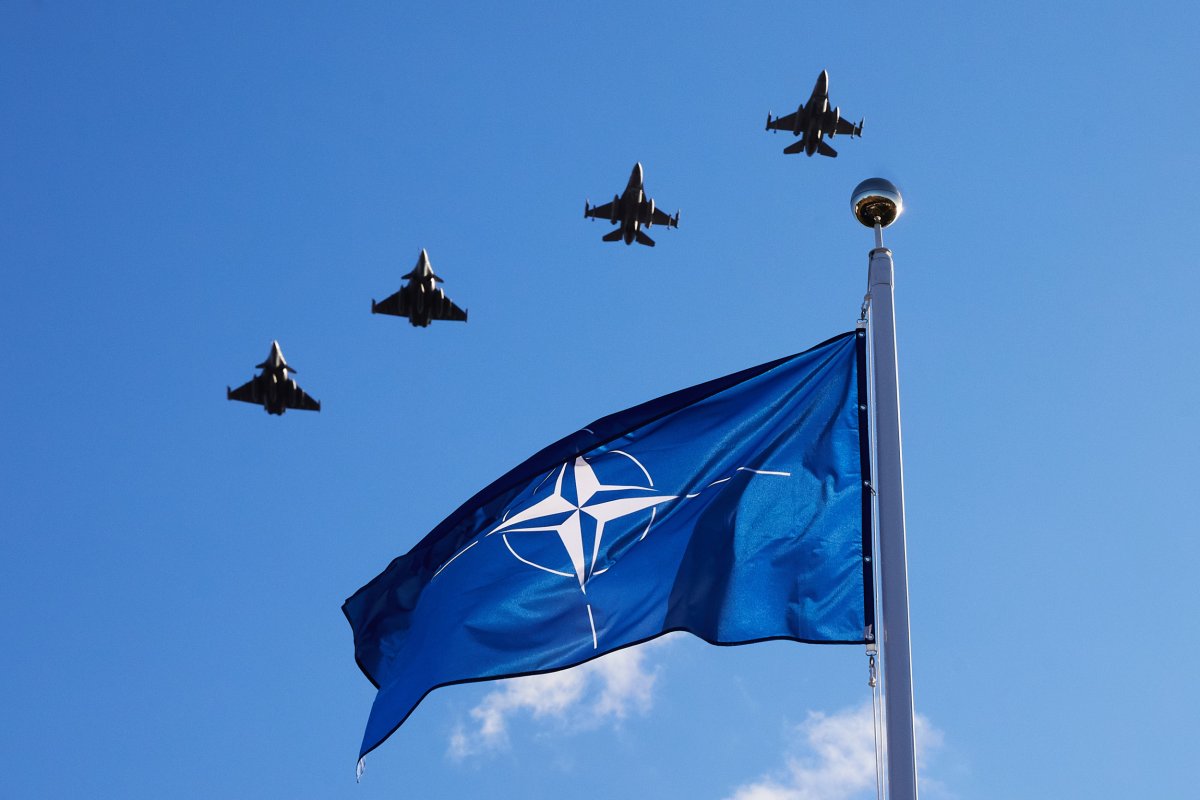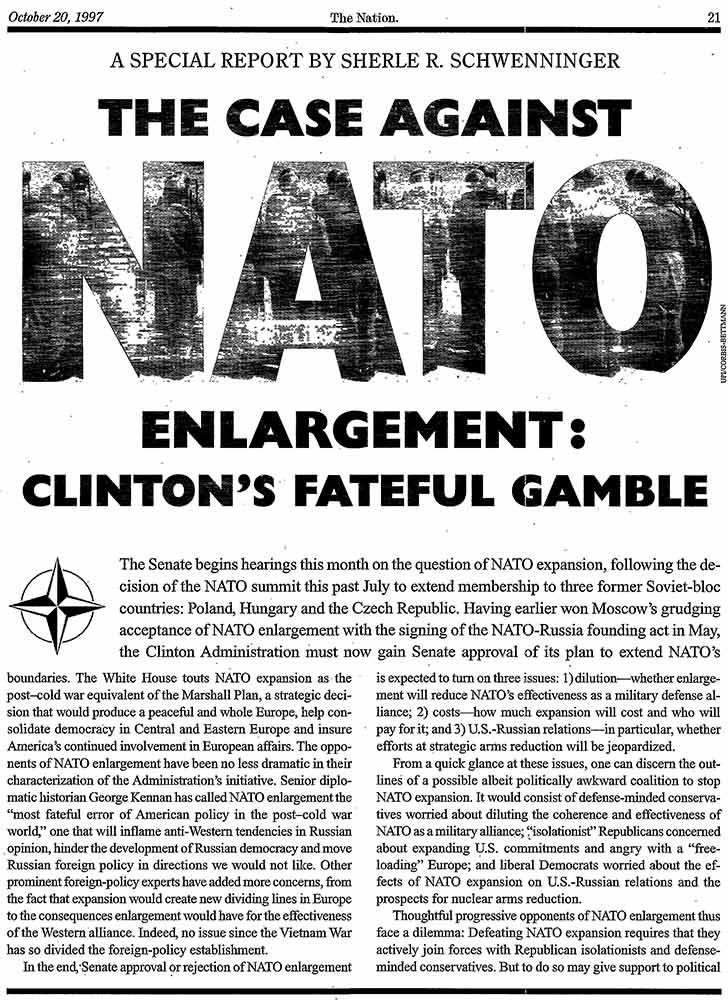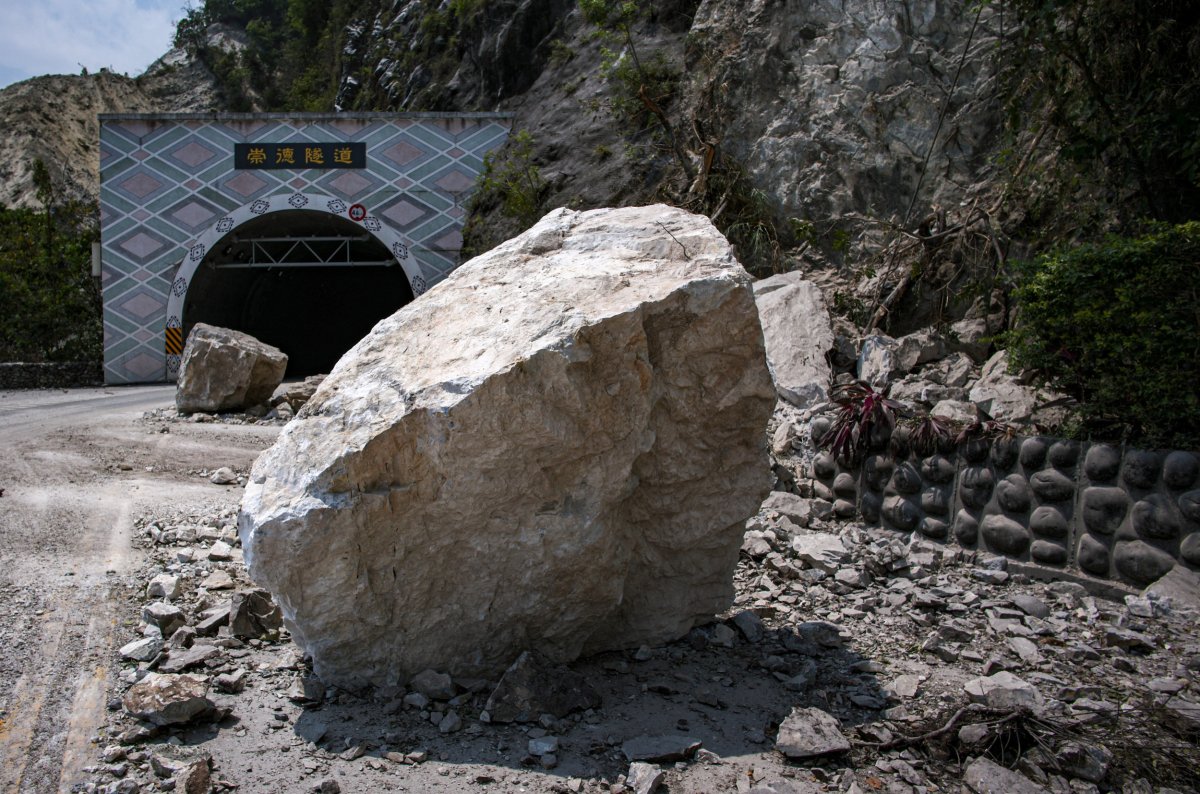The Cold War alliance long ago outlived its usefulness. But then Nation contributors have been skeptical since the beginning.
The 75th anniversary of the North Atlantic Treaty Organization (NATO) offers a chance to reflect on the pact’s Cold War origins, checkered history, and uncertain future. Created in 1949 to formalize American security guarantees in Western Europe, NATO immediately signaled its intention to expand beyond the North Atlantic region designated in its name. Almost as quickly, The Nation expressed skepticism about this plan. In 1951, we objected to the idea of adding Turkey and Greece to the alliance. Bringing those countries in would “effectually end the concept of a democratic union in defense of the ‘free world,’” the magazine argued. “What we are constructing instead, with breathtaking speed, is an old-fashioned military alliance equipped with ‘fantastic’ new-fashioned weapons.”
A year later, one of The Nation’s regular correspondents on foreign affairs, the Spanish writer and socialist politician Julio Àlvarez del Vayo, voiced more concerns. Support for the internationalist vision behind the United Nations was being supplanted by NATO’s more militaristic approach, Àlvarez del Vayo wrote. “The attempt should be exposed for the sake of the millions of people here and abroad who still take seriously the democratic slogans enunciated during the war.”
NATO was founded to address a specific historical moment, but its strategic purpose since that moment passed has never been entirely clear. On the group’s 10th anniversary, in 1959, the English historian Geoffrey Barraclough wrote in these pages that NATO’s future was in doubt. “Even its warmest upholders are conscious of its shortcomings,” Barraclough observed. “World conditions have changed in fundamental ways since NATO was formed in 1949”—notably, with Joseph Stalin’s death—“but the organization has not changed with them.”
In 1995, when Washington’s foreign-policy “Blob” seized on the end of the Cold War as an opportunity to expand rather than wind down the pact, Nation writers warned—loudly and often—that such a step would only make everyone less secure. “A revival of East-West conflict along the lines of the Cold War is hardly inevitable,” Matthew Evangelista wrote. “But few geopolitical decisions would encourage it more than expansion of NATO into Eastern Europe. If the Clinton administration insists on enlarging NATO, it runs a serious risk of rupturing relations with Moscow, a break that could be disastrous at a time when democratic reformers in Russia already face the distinct possibility of being overwhelmed by the forces of the past.”
Two years later, Sherle Schwenninger laid out “The Case Against NATO Enlargement.” Expanding NATO, he warned, would set back nuclear disarmament efforts and hinder reconciliation. Given that Russia was not consulted in the decision to swell NATO right up to its borders, Schwenninger noted in one haunting passage, “Russian nationalists could reasonably ask…why should Moscow allow the United States to have a say in areas bordering Russia and in its sphere of influence?”
Richard Kreitner is a contributing writer and the author of Break It Up: Secession, Division, and the Secret History of America's Imperfect Union. His writings are at www.richardkreitner.com.
Published Apr 04, 2024
By Alexander Fabino
Reporter, Economy & Finance
As the North Atlantic Treaty Organization (NATO) marks its 75th anniversary, a reflective look into the contributions of its founding member, the United States, reveals its important role, with more than 68 percent of last year's total budget coming from the U.S. alone.
Since its inception on April 4, 1949, amid the post-World War II recovery period, NATO has stood as a bulwark of collective security against the specter of aggression, with the U.S. playing perhaps the most important role in its financial and strategic underpinnings.
The foundation of NATO, motivated by the need to secure Western Europe against the looming threat of Soviet expansion, required political and financial solidarity.
Over the past 75 years, the U.S. contributed $21.9 trillion to NATO's defense budget, according to its yearly Defense Expenditure of NATO Countries report, significantly more than its 31 peers.

That's mostly because the U.S. has a higher gross domestic product (GDP) than other countries, which is what NATO contributions are based on.
Last year, the U.S. contributed 68 percent, which worked out to be 3.49 percent of America's total GDP for $860 billion of the $1.26 trillion NATO spent. Canada contributed 1.38 percent of its GDP at $28.95 billion (2.29 percent of total contributions), while the collective European allies accounted for $375.1 billion (29.68 percent) of the total budget.
According to its website, in 2014, NATO signed the Defense Investment Pledge, urging member countries to allocate at least 2 percent of their GDP toward defense spending. It is a guideline that acts as more of a recommendation than requirement.
It was hoped that countries contributing less would endeavor to meet the target by 2024. NATO said that by the end of this year, 18 allies are expected to meet the guideline, a six-fold increase from when the pledge was signed in 2014.
Last year, Poland allocated 3.9 percent of its GDP, surpassing the U.S. in percentage terms. Greece, Estonia, Lithuania, Finland, Romania, Hungary, Latvia, the U.K. and Slovakia contributed more than the 2 percent guideline last year.
NATO members defense expenditure for 2023
This chart illustrates the defense spending of NATO members for
2023, detailing the proportion of GDP allocated to defense and
the annual growth in real terms
The investments do not translate into direct payments to NATO. They encompass national defense spending, including domestic personnel costs, equipment purchases, and infrastructure investments, which supports NATO's operational readiness and its strategic initiatives across the globe.
The alliance now includes 31 member countries across North America and Europe, with Finland and Sweden the newest. They joined on April 4, 2023, and March 7 of this year, respectively, spurred by Russia's invasion of Ukraine on February 24, 2022.
NATO's composition is marked by the absence of major powers like China, India, Japan, and Russia.



